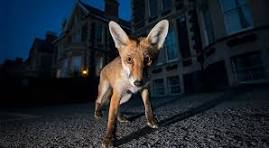All around the UK, our councils, nature conservation organizations and local wildlife groups try to ensure that we protect our green spaces to provide a habitat to mammals, reptiles and birds and perhaps, less obviously, to the insects and invertebrates that are vital for our environment and our own existence.
How Have Animals Adapted to Urban Environments?
There are many ways in which animals have adapted to the urban lifestyle. Resilient and generalist species tend to do best in our urban jungles and their adaptations often make them different from their countryside counterparts.
Peregrine falcons are a prime example; part of their city success is linked to them learning to catch prey at night using artificial light which would not be present in their traditional cliff and mountainside habitat. Passerine bird species also show an adaptation in that they sing at higher pitches than those living in the countryside. This is thought to be a result of the birds trying to make their calls stand out over the lower-pitched rumblings of traffic and other man-made noises.
A classic example is the peppered moth (Biston betularia), the moth famously shifted from a white variety to a black variety in heavily polluted cities during the 19th and early 20th centuries. This form was more successful at avoiding predation when perched on sooty walls than the white variety, but the colour shift switched back to white in the years following the introduction of clean air legislation in 1956 as the darker moths became gradually more vulnerable to predation. Apparently for some animals, it’s all in the brains. Snell-Rood and Wick (2013) found that mice and voles in urban areas of the US have larger brains than their countryside cousins. This supports the theory that the diversity and complexity of cities compared to countryside locations increases cognition in some species.
Animals play a variety of roles in our urban ecosystems. For example, birds of prey and urban foxes (along with our beloved felines) provide some level of pest control, which is helpful considering that you’re never far away from one of our ratty friends Bees are a common visitor to our urban parks and gardens and as a prime pollinator, they are vital for pollinating our plants. This includes our crops, vital for our food and agriculture industry. We’d be in a sorry state without them!
Temperature Regulation and Anti-Pollution
Trees and other vegetation also provide a range of beneficial effects. They are natural temperature coolers which can help to reduce the spike in summertime city temperatures caused by the urban heat island effect. Trees cool the air around them by shading and evapotranspiration, whilst at the same time providing food and shelter for other wildlife. Planting trees and vegetation to act as a natural barrier is also a great way to reduce noise pollution in areas where heavy traffic and residential housing meet. They can also help to remove pollution from the atmosphere.
Health and Well Being
Ultimately, wildlife is good for our well-being. Studies have increasingly shown the benefits that nature brings. Nature has been proven to reduce hypertension, respiratory illnesses, improve vitality and mood, benefit issues of mental well-being such as anxiety and restore attention capacity and mental fatigue.
To attract wildlife into urban spaces we need to design the space to adequately meet the animal’s needs. For example, planting a range of flowers to attract bees and butterflies (cotoneaster and buddleia are good urban growing examples), night-scented plants for bats, shrubs that flower throughout the year and evergreen trees to attract a diverse range of wildlife and provide shelter and nesting options for mammals, birds and insects.
Joining up green areas is key to sustaining wildlife. Having green spaces in an urban area is great, but wildlife is more likely to flourish if there is a connected network of habitats rather than isolated patches. Every little bit of green helps.
